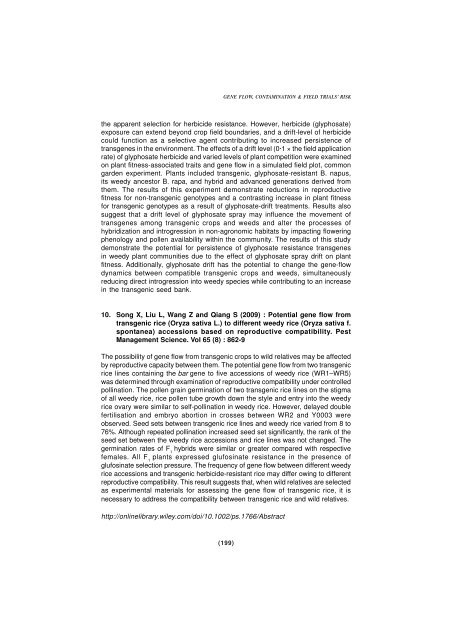omb3dyw
omb3dyw
omb3dyw
You also want an ePaper? Increase the reach of your titles
YUMPU automatically turns print PDFs into web optimized ePapers that Google loves.
GENE FLOW, CONTAMINATION & FIELD TRIALS’ RISKthe apparent selection for herbicide resistance. However, herbicide (glyphosate)exposure can extend beyond crop field boundaries, and a drift-level of herbicidecould function as a selective agent contributing to increased persistence oftransgenes in the environment. The effects of a drift level (0·1 × the field applicationrate) of glyphosate herbicide and varied levels of plant competition were examinedon plant fitness-associated traits and gene flow in a simulated field plot, commongarden experiment. Plants included transgenic, glyphosate-resistant B. napus,its weedy ancestor B. rapa, and hybrid and advanced generations derived fromthem. The results of this experiment demonstrate reductions in reproductivefitness for non-transgenic genotypes and a contrasting increase in plant fitnessfor transgenic genotypes as a result of glyphosate-drift treatments. Results alsosuggest that a drift level of glyphosate spray may influence the movement oftransgenes among transgenic crops and weeds and alter the processes ofhybridization and introgression in non-agronomic habitats by impacting floweringphenology and pollen availability within the community. The results of this studydemonstrate the potential for persistence of glyphosate resistance transgenesin weedy plant communities due to the effect of glyphosate spray drift on plantfitness. Additionally, glyphosate drift has the potential to change the gene-flowdynamics between compatible transgenic crops and weeds, simultaneouslyreducing direct introgression into weedy species while contributing to an increasein the transgenic seed bank.10. Song X, Liu L, Wang Z and Qiang S (2009) : Potential gene flow fromtransgenic rice (Oryza sativa L.) to different weedy rice (Oryza sativa f.spontanea) accessions based on reproductive compatibility. PestManagement Science. Vol 65 (8) : 862-9The possibility of gene flow from transgenic crops to wild relatives may be affectedby reproductive capacity between them. The potential gene flow from two transgenicrice lines containing the bar gene to five accessions of weedy rice (WR1–WR5)was determined through examination of reproductive compatibility under controlledpollination. The pollen grain germination of two transgenic rice lines on the stigmaof all weedy rice, rice pollen tube growth down the style and entry into the weedyrice ovary were similar to self-pollination in weedy rice. However, delayed doublefertilisation and embryo abortion in crosses between WR2 and Y0003 wereobserved. Seed sets between transgenic rice lines and weedy rice varied from 8 to76%. Although repeated pollination increased seed set significantly, the rank of theseed set between the weedy rice accessions and rice lines was not changed. Thegermination rates of F 1hybrids were similar or greater compared with respectivefemales. All F 1plants expressed glufosinate resistance in the presence ofglufosinate selection pressure. The frequency of gene flow between different weedyrice accessions and transgenic herbicide-resistant rice may differ owing to differentreproductive compatibility. This result suggests that, when wild relatives are selectedas experimental materials for assessing the gene flow of transgenic rice, it isnecessary to address the compatibility between transgenic rice and wild relatives.http://onlinelibrary.wiley.com/doi/10.1002/ps.1766/Abstract(199)


